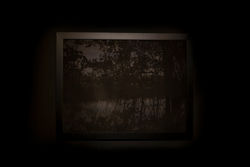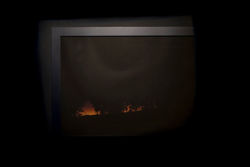top of page
Overnight, 2009
 Overnight, 2009 Installation views. Vistas de sala Oficina #1. Caracas, Venezuela |  Overnight, 2009 Installation views. Vistas de sala Oficina #1. Caracas, Venezuela |  Overnight, 2009 Installation views. Vistas de sala Oficina #1. Caracas, Venezuela |  Overnight, 2009 Installation views. Vistas de sala Oficina #1. Caracas, Venezuela |  Overnight, 2009 Installation views. Vistas de sala Oficina #1. Caracas, Venezuela |
|---|---|---|---|---|
 Overnight, 2009 Installation views. Vistas de sala Oficina #1. Caracas, Venezuela |  Overnight, 2009 Installation views. Vistas de sala Oficina #1. Caracas, Venezuela |  Overnight, 2009 Installation views. Vistas de sala Oficina #1. Caracas, Venezuela |  Overnight, 2009 Installation views. Vistas de sala Oficina #1. Caracas, Venezuela |  Overnight, 2009 Installation views. Vistas de sala Oficina #1. Caracas, Venezuela |
.
A place in the dark.
Carlos E. Palacios
There is something more than darkness in the recent photographs of Suwon Lee. Each image of this series supposes
that a mystery lies hidden behind its dense penumbra. A first glimpse places us in front of intriguing and profound
photos, like a nocturnal walk in an unknown forest.
The best way to look at these images is as a group. The sequential observation opens the possibility of constructing
a mental tale which incorporates, as its utmost principal purpose, to the dense blackness of these scenarios from their emotional value: a sensitive feature that defines the good examples of landscape in the historic panorama of art.
Many of her previous works are presented as rhetorical mechanisms from other stories, these being of a more personal nature. This is the case of The Stranger from 2004, an enigmatic photo that juxtaposes the continuous interaction
of faraway traditions and customs from her family origins in relationship to the latent Venezuelanness of the artist.
The image cannot be more eloquent: The very same Suwon Lee holding a suitcase marked with the phrase “Get a Life”, looking towards the horizon, from the coastal landscape of our Caribbean geography.
Likewise, in many of her previous projects (which flow through a wide catalogue of varied artistic techniques) the artist sketches a tale about her life and her ancestry with works that speak about the rituals and the imaginary of her Korean ancestry. In the installation she designed to show this group of works, darkness was also radically present: on this occasion, like a strategy that molded us into the exhibition space like the place –the landscape- of dreams and familiar names.
This brief look around the work of Suwon Lee serves to understand the pertinence of this recent group of images.
Her discreet and determined sensibility rests upon two discursive elements strategically related: on one hand the causes
of her works which are none other than her memories and places of her glances; on the other the power of the chiaroscuro as a mechanism of a precise emotion for those same causes. In this regard, Suwon Lee’s chiaroscuro work results particularly surprising within the Venezuelan contemporary arts scene. This chiaroscuro is particularly evident in the photographs amassed for this exhibition, which is titled Overnight with all due intention.
Regarding this suggestive and poetic value that the artist confers to the light (or lack thereof), it is worth to note the 2008 video titled “Hope/Despair” and especially, the photograph titled “La Espera” (Waiting), which belongs to this last series.
In both works, the candle holds a central purpose. The candle which in the video is extinguished tracing a journey from total luminosity to the most absolute obscurity and the dark photograph that evokes identically, the group of scenes
of the utmost representative of the chiaroscuro baroque painting such as Georges de La Tour, offer much more than historical clues. Suwon Lee not only bestows upon the light the same values that are classical of the baroque painting but she also reviews these quotes with true technical and conceptual efficiency. A hidden strategy is anchored within
the contemporary pertinence of all this mystical evocation: the allegorical echo heard behind these dark places and in the suspended time of this lonely waiting, is none other than that which reminds us gloomily that ours is also a landscape
in the dar
.
Un lugar a oscuras.
Carlos E. Palacios
Hay algo mas que oscuridad en las recientes fotografías de Suwon Lee. Cada imagen de esta serie supone que un misterio se esconde detrás de su densa penumbra. Un primer acercamiento nos coloca frente a unas fotos intrigantes y profundas, como el paseo nocturno por un bosque desconocido.
La mejor manera de mirar estas imágenes es en conjunto. Su observancia secuencial nos abre a la posibilidad de construirnos un relato mental que incorpora, como su motivo principalísimo, a la densa negritud de estos escenarios desde su valor emocional: Un rasgo sensible que define a los buenos ejemplos del paisajismo en el panorama histórico del arte.
Muchas de sus obras anteriores se nos proponen como dispositivos retóricos de otras narraciones, estas de orden mas personal. Es el caso de Get a Life de 2004, una enigmática fotografía que contrapone la continua interacción de las lejanísimas tradiciones y costumbres de su origen familiar en relación a la venezolanidad patente de la artista. La imagen no puede ser mas elocuente: La propia Suwon Lee con una maleta marcada con el título de la obra, mirando hacia
el horizonte, desde el paisaje costeño de nuestra geografía caribeña.
Igualmente, en muchas propuestas anteriores (y que discurren a través de un amplio catálogo de diversas técnicas artísticas) la artista dibuja una narración sobre su vida y la de los suyos a partir de unas obras que nos hablan de los ritos
y el imaginario de sus antepasados coreanos. En la instalación que diseñó para mostrar este grupo de piezas, la oscuridad también estuvo radicalmente presente: en esta ocasión, como una estrategia que nos modeló el espacio de exhibición
como el lugar –el paisaje- de los sueños y los nombres familiares.
Sirva esta breve recorrido por la obra de Suwon Lee para entender la pertinencia de este reciente conjunto de imágenes.
Su discreta y decidida sensibilidad descansa sobre dos elementos discursivos estratégicamente afines: por un lado los motivos de su obra que no son otros que sus recuerdos y los lugares de su mirada; por otro lado, el poder del claroscuro como dispositivo de una emoción precisa para esos mismos motivos. En este sentido, resulta particularmente sorprendente en el medio artístico venezolano contemporáneo la obra tenebrista de Suwon Lee. Tenebrismo que se hace particularmente evidente en las fotografías reunidas en esta exposición, que no por azar se intitula Overnight.
Sobre este valor sugerente y poético que la artista le confiere a la luz (o a su ausencia), vale la pena resaltar su video
de 2008 intitulado Hope/Despair y sobretodo, la fotografía intitulada La Espera, que pertenece a esta última serie.
En ambas obras, la vela se asume como un motivo central. El cirio que en el video se extingue trazando un viaje desde
la luminosidad total a la obscuridad mas absoluta y la sombría fotografía que evoca idéntica, el conjunto de escenas
del mas tenebristas de los pintores del barroco francés como fue Georges de La Tour, ofrecen mucho mas que pistas históricas. Suwon Lee no sólo le confiere a la luz valores clásicos de la pintura del barroco sino que estas citas se reseñan con verdadera eficacia, tanto técnica como conceptual. Una estrategia oculta se ancla en la pertinencia contemporánea
de toda esta evocación mística: El eco alegórico que se escucha detrás de estos lugares oscuros y en el tiempo suspendido de esta tenebrosa espera solitaria, no es otro que aquel que nos recuerda tenebrosamente que el nuestro es ahora
también un paisaje a oscuras.
.
works.
Overnight, 2009
.
expo.
Overnight. Oficina #1. Caracas, Venezuela 2009
. noche . night . nocturne . nocturno . paisaje . dawn . landscape . paisaje . luz . oscuridad . vela . penumbra
bottom of page
